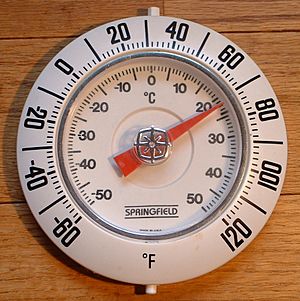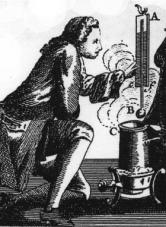Fahrenheit facts for kids
Fahrenheit is a way to measure temperature. It's often called a degree Fahrenheit, and its symbol is °F. You can change Fahrenheit to Celsius using a special math formula: C = 5/9 x (F − 32).
Fahrenheit is still the main way to measure temperature in the United States and its territories. Some other places that use it include Palau, the Federated States of Micronesia, the Marshall Islands, the Cayman Islands, and Liberia. In the United Kingdom, some older people still use Fahrenheit, and you might see it in some weather forecasts.
Other countries like Antigua and Barbuda, Saint Kitts and Nevis, the Bahamas, and Belize use Fahrenheit along with Celsius. Some British islands, like the Virgin Islands and Bermuda, also use both scales. Most other countries around the world now use Celsius, which was created 18 years after the Fahrenheit scale.
Contents
History of Fahrenheit
The Fahrenheit temperature scale was created in 1724 by a German scientist named Daniel Gabriel Fahrenheit. He based his work on ideas from another scientist, Ole Rømer.
Fahrenheit wanted to make his temperature scale very precise. He started by setting the freezing point of water at 32 degrees. He then set the normal human body temperature at 96 degrees. This meant there were 64 steps between freezing water and body temperature. He could easily mark these steps on his thermometers.
Later, scientists decided to make the scale even more exact. They set the freezing point of water at exactly 32 °F and the boiling point of water at exactly 212 °F. This means there are 180 degrees between freezing and boiling water. Because of this small change, normal human body temperature is now about 98.6 °F.
In the 1900s, most of the world started using the Celsius scale instead of Fahrenheit. Celsius is often seen as easier to use and is now the most common way to measure temperature around the globe. The United States is one of the main places where Fahrenheit is still widely used.
Examples of Fahrenheit Temperatures
On the Fahrenheit scale, water freezes at 32°F. It boils at 212°F.
- Room temperature is usually around 70 °F.
- A human's body temperature is normally about 98.6 °F.
- The coldest possible temperature, called Absolute zero, is –459.67 °F.
How to Convert Temperatures
It's easy to change temperatures between Fahrenheit and Celsius. Here are the main formulas:
- To change Fahrenheit (f) to Celsius (c): c = f − 321.8
- To change Celsius (c) to Fahrenheit (f): f = c × 1.8 + 32
There's also a cool fact: −40 °F is the same temperature as −40 °C!
Related pages
See also
 In Spanish: Grado Fahrenheit para niños
In Spanish: Grado Fahrenheit para niños



